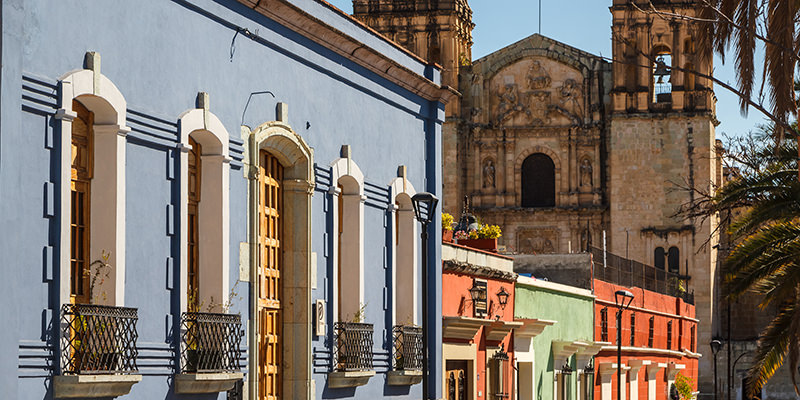I’m sitting in a park in Oaxaca City and there are hipsters all around me drinking craft beer and singing along to Creed. At the food truck park in San Felipe del Agua, an upscale neighborhood just north of Oaxaca City’s center, groups of smiling young professionals and American tourists sit at picnic tables under the palm leaves of a large palapa. They pick at gourmet salads made with biodynamically grown organic greens from Biohuacal and sip on espressos from Café con Leche, or cold craft brews from The Beer Truck Company. That’s when someone decides that what this party really needs is the music of Creed. When “Arms Wide Open” begins, people all around me start crooning along to the 1999 hit. It’s not quite indie rock, but it’s just the right mix of nostalgia and Americana for this hip crowd.
It’s a scene that differs from much of Oaxaca City. Oaxaca is considered one of the poorest states in Mexico, contributing less than two percent of the country’s GDP. Thirty percent of the state’s economy comes from the tourism industry, and while Oaxaca does get its share of American and international tourists, most are visiting from within Mexico. On Friday night, Oaxaca City’s bars are filled like those of any other Mexican town, with young women in miniskirts lining up to dance and drink, towering over their dates in six-inch heels, precarious on the cobblestone streets. In bars all over Oaxaca City, beer is served by the bucket, half a dozen Coronas or Dos Equis lagers on ice, and the most popular mixed drink starts with the delivery of three liters of Coke and a bottle of Johnnie Walker Red. If the bar serves food at all, it’s probably something involving cold hot dogs or sliced ham with string cheese. At street fairs and seaside bars, Oaxacans drink not just ice cold beers, but an array of savory or sweet beer cocktails. A Michelada brings a mix of fresh lemon juice, chile, and any number of added ingredients (tamarind-based chamoy, Worcestershire sauce, even the occasional soy sauce appearance) to a beer. It makes a great match for a hot meal or just a hot afternoon, with its spicy and salty lemon flavor. Gomichelas are the fruity bubble tea of beer, with gummi candy and fruity syrup or juice turning your standard Mexican beer into a sweet and spicy alcoholic soda.
These concoctions are standard fare for most Oaxacans, not trendy but very popular. The new look of beer in Mexico, however, is hipper. It’s so hip, in fact, that it’s hipster. In fact, “hipster” has become a verb in Mexico – hipsterear, meaning, to go out and do hipster things. And at the epicenter of this hipster scene is craft beer.
Mexican beer culture actually started with small craft companies. But in the decades after it became popular, the market was almost entirely bought out by the country’s two main producers. After nearly a century since beer’s first big boom, craft beer is making a comeback in a new way; the artisan and the connoisseur have joined forces.
It’s tough to root out the origins of the hipster influence. Is it the influence of American tourists and expats, in search of comforts that remind them of home? Are Mexicans of means bringing U.S. culture back with them when they return from school or work on the other side of the border? Or do these hip tastes and aesthetics find their way into Mexican culture the same way that English has for most of my Oaxacan friends — via TV shows, movies, and popular music? It’s impossible to tell, with all these individual influences coming together in Oaxaca’s streets, who is a trendsetter and who is simply along for the ride. One thing’s certain, though: It’s impossible to untangle hipsterear from the force of gentrification in Mexico.
Despite persistent poverty in the Southern states, Mexico’s middle class has been consistently growing, and Oaxaca is no exception. At the downtown “gourmet market” Alhondiga Reforma, the customers come in many shapes and sizes, but the young professional is also well-represented. Just over half of Oaxaca City’s population considers themselves to belong to the middle class. For the millennials who frequent Oaxaca’s hippest spots, almost two-thirds fall into this category. With smaller families, fewer expenses, and more active social lives, this middle-class income keeps the hospitality industry alive and well. And changing!
Some of Oaxaca’s most hipster spots are not high-end restaurants but annual events. The city’s mezcal festival celebrated its 19th year in the summer of 2016, and the artisanal beer festival recently hosted the second such annual event. But in a town of more than 250,000 people, where restaurants and retailers come and go with the seasons, there are a few hot spots that seem to be here to stay. Craft beers are sold at hookah bars, food truck parks, mezcalerias, and hot dinner spots alike.
Bars that serve craft beer are often the opposite of the simple corner cerveceria or comida, which may have as few as two beer options. Alhondiga, the gourmet market, offers more than 30 options from a dozen different makers, both local and national, in addition to a decent selection of commercial fare from Mexico and beyond. The menu boasts everything from bock to stout, wheat beer to pilsner, and a number of hoppy lagers.
Sien, a bartender at Alhondiga, tells me that even with the regular lunch crowd of 20- and 30-somethings, most of his customers aren’t Oaxacan. “They’re anywhere from 20 to 50 years old, but most are tourists who come from the Northern states,” Sien says.
The metropolitan Federal District and the state of Mexico combined make up more than a quarter of the country’s wealth, and some of that wealth does find its way to the southern shores and valleys of Oaxaca, thanks at least in part to young people playing hipster.

